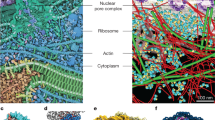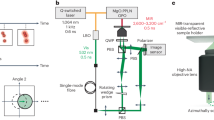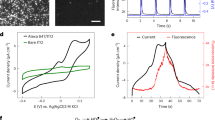Abstract
Recording light-microscopy images of large, nontransparent specimens, such as developing multicellular organisms, is complicated by decreased contrast resulting from light scattering. Early zebrafish development can be captured by standard light-sheet microscopy, but new imaging strategies are required to obtain high-quality data of late development or of less transparent organisms. We combined digital scanned laser light-sheet fluorescence microscopy with incoherent structured-illumination microscopy (DSLM-SI) and created structured-illumination patterns with continuously adjustable frequencies. Our method discriminates the specimen-related scattered background from signal fluorescence, thereby removing out-of-focus light and optimizing the contrast of in-focus structures. DSLM-SI provides rapid control of the illumination pattern, exceptional imaging quality and high imaging speeds. We performed long-term imaging of zebrafish development for 58 h and fast multiple-view imaging of early Drosophila melanogaster development. We reconstructed cell positions over time from the Drosophila DSLM-SI data and created a fly digital embryo.
This is a preview of subscription content, access via your institution
Access options
Subscribe to this journal
Receive 12 print issues and online access
$259.00 per year
only $21.58 per issue
Buy this article
- Purchase on Springer Link
- Instant access to full article PDF
Prices may be subject to local taxes which are calculated during checkout




Similar content being viewed by others
Change history
30 July 2010
In the version of this supplementary file originally posted online, the Matlab data file was switched with the data file in the other supplementary zip file accompanying this manuscript. The error has been corrected in this file as of 30 July 2010.
References
Bao, Z. et al. Automated cell lineage tracing in Caenorhabditis elegans. Proc. Natl. Acad. Sci. USA 103, 2707–2712 (2006).
Megason, S.G. & Fraser, S.E. Imaging in systems biology. Cell 130, 784–795 (2007).
Fowlkes, C.C. et al. A quantitative spatiotemporal atlas of gene expression in the Drosophila blastoderm. Cell 133, 364–374 (2008).
McMahon, A., Supatto, W., Fraser, S.E. & Stathopoulos, A. Dynamic analyses of Drosophila gastrulation provide insights into collective cell migration. Science 322, 1546–1550 (2008).
Murray, J.I. et al. Automated analysis of embryonic gene expression with cellular resolution in C. elegans. Nat. Methods 5, 703–709 (2008).
Keller, P.J., Schmidt, A.D., Wittbrodt, J. & Stelzer, E.H.K. Reconstruction of zebrafish early embryonic development by scanned light sheet microscopy. Science 322, 1065–1069 (2008).
Keller, P.J. & Stelzer, E.H. Quantitative in vivo imaging of entire embryos with digital scanned laser light sheet fluorescence microscopy. Curr. Opin. Neurobiol. 18, 624–632 (2008).
Long, F., Peng, H., Liu, X., Kim, S.K. & Myers, E. A 3D digital atlas of C. elegans and its application to single-cell analyses. Nat. Methods 6, 667–672 (2009).
Liu, X. et al. Analysis of cell fate from single-cell gene expression profiles in C. elegans. Cell 139, 623–633 (2009).
Neil, M.A., Juskaitis, R. & Wilson, T. Method of obtaining optical sectioning by using structured light in a conventional microscope. Opt. Lett. 22, 1905–1907 (1997).
Huisken, J., Swoger, J., Del Bene, F., Wittbrodt, J. & Stelzer, E.H.K. Optical sectioning deep inside live embryos by selective plane illumination microscopy. Science 305, 1007–1009 (2004).
Breuninger, T., Greger, K. & Stelzer, E.H. Lateral modulation boosts image quality in single plane illumination fluorescence microscopy. Opt. Lett. 32, 1938–1940 (2007).
Frohn, J.T., Knapp, H.F. & Stemmer, A. True optical resolution beyond the Rayleigh limit achieved by standing wave illumination. Proc. Natl. Acad. Sci. USA 97, 7232–7236 (2000).
Gustafsson, M.G. Surpassing the lateral resolution limit by a factor of two using structured illumination microscopy. J. Microsc. 198, 82–87 (2000).
Gustafsson, M.G. Nonlinear structured-illumination microscopy: wide-field fluorescence imaging with theoretically unlimited resolution. Proc. Natl. Acad. Sci. USA 102, 13081–13086 (2005).
Kner, P., Chhun, B.B., Griffis, E.R., Winoto, L. & Gustafsson, M.G. Super-resolution video microscopy of live cells by structured illumination. Nat. Methods 6, 339–342 (2009).
Supatto, W., McMahon, A., Fraser, S.E. & Stathopoulos, A. Quantitative imaging of collective cell migration during Drosophila gastrulation: multiphoton microscopy and computational analysis. Nat. Protocols 4, 1397–1412 (2009).
Marr, D. & Hildreth, E. Theory of edge detection. Proc. R. Soc. Lond. B 207, 187–217 (1980).
Besl, P.J. & McKay, N.D. A method for registration of 3-D shapes. IEEE Trans. Pattern Anal. Mach. Intell. 14, 239–256 (1992).
Richardson, W.H. Bayesian-based iterative method of image restoration. J. Opt. Soc. Am. 62, 55–59 (1972).
Yaroslavsky, A.N. et al. Optical properties of selected native and coagulated human brain tissues in vitro in the visible and near infrared spectral range. Phys. Med. Biol. 47, 2059–2073 (2002).
Acknowledgements
We thank members of the mechanical workshop of the European Molecular Biology Laboratory for custom hardware; A. Riedinger and G. Ritter for custom electronics; F. Härle and A. Riedinger for custom microscope software; J. Topczewski (Northwestern University) for the ras-eGFP zebrafish strain; M. Ludwig and K. White (University of Chicago) for the histone-eGFP Drosophila strain; and A. Diaspro, F. Cella and P. Theer for helpful discussions. Financial support was provided to A.D.S. by Hartmut Hoffmann-Berling International Graduate School of Molecular and Cellular Biology.
Author information
Authors and Affiliations
Contributions
P.J.K. and E.H.K.S. conceived the research. P.J.K. implemented DSLM-SI, conducted the Drosophila experiments, performed the reconstructions, analyzed the DSLM-SI data and wrote the paper. P.J.K., A.D.S. and J.W. conducted the zebrafish experiments. P.J.K., A.S., K.K. and Z.B. constructed the fly digital embryo. All authors commented on the manuscript.
Corresponding authors
Ethics declarations
Competing interests
E.H.K.S. filed a patent application for light sheet–based structured illumination fluorescence microscopy: US patent application 11/592, 331, 2006.
Supplementary information
Supplementary Text and Figures
Supplementary Figures 1– 16 and Supplementary Table 1 (PDF 10119 kb)
Supplementary Video 1
DSLM structured illumination. A schematic illustration of the DSLM with an intensity-modulated laser illumination pattern. The sinusoidal intensity profile was generated by scanning the beam through the specimen at a constant speed while synchronously modulating the laser intensity with an acousto-optical tunable filter (AOTF). Inset, close-up of the illuminated specimen inside the specimen chamber. (MOV 1492 kb)
Supplementary Video 2
Fast multichannel imaging of early zebrafish embryogenesis with DSLM-SI. Maximum-intensity projections of a DSLM time-lapse recording of a membrane- and nuclei-labeled zebrafish embryo. Membranes were imaged using structured illumination (SI-25, top row), nuclei using standard light sheet illumination (bottom left). The top-most cell layer (the enveloping layer, EVL) was removed computationally in the ras-eGFP channel and is shown on the right, separate from the deeper cell layers (left). The egg diameter is approximately 720 μm. (MOV 13593 kb)
Supplementary Video 3
DSLM-SI long-term imaging of a membrane-labeled zebrafish embryo. Maximum-intensity projections of a DSLM-SI time-lapse recording of a zebrafish embryo (ras-eGFP transgenic line), during the period 9–67 h.p.f. To provide an unobstructed view of the embryo, the top-most cell layer (the enveloping layer, EVL) was removed computationally. The egg diameter is approximately 720 μm. Images were deconvolved with the Lucy-Richardson algorithm (10 iterations). Fluorescence was detected with a Carl Zeiss C-Apochromat 10 × 0.45 W objective. (MOV 39342 kb)
Supplementary Video 4
Multiple-view imaging of Drosophila embryogenesis with DSLM-SI. Maximum-intensity projections of a DSLM-SI multiple-view time-lapse recording of a nuclei-labeled Drosophila embryo. The embryo is approximately 520 μm long. (MOV 10659 kb)
Supplementary Video 5
Reconstructing Drosophila embryogenesis from DSLM-SI data. Computational alignment of the four point clouds representing the nuclei detected in the four DSLM-SI views of the developing Drosophila embryo. Nuclei shown in different colors originate from different microscopic views. (MOV 13702 kb)
Supplementary Video 6
The Drosophila digital embryo. Different perspectives of the fly digital embryo, obtained by multiple-view fusion of the four nuclear point clouds and color-coding of directed regional nuclei movement speeds over 10-min intervals (0–0.8 μm min−1, cyan to orange). (MOV 12929 kb)
Supplementary Data 1
Raw reconstruction of early Drosophila wild-type development. (ZIP 50725 kb)
Supplementary Data 2
Fused reconstruction of early Drosophila wild-type development. (ZIP 21054 kb)
Rights and permissions
About this article
Cite this article
Keller, P., Schmidt, A., Santella, A. et al. Fast, high-contrast imaging of animal development with scanned light sheet–based structured-illumination microscopy. Nat Methods 7, 637–642 (2010). https://doi.org/10.1038/nmeth.1476
Received:
Accepted:
Published:
Issue Date:
DOI: https://doi.org/10.1038/nmeth.1476



